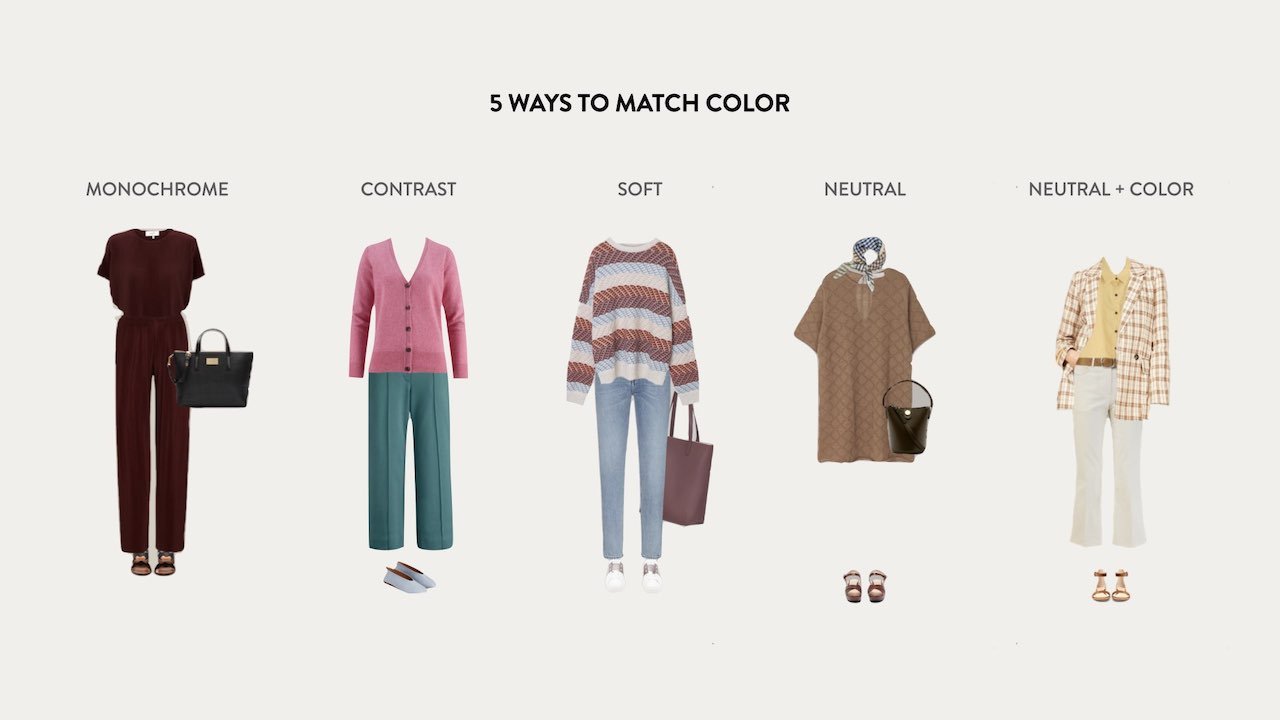
Color coordination is crucial for creating visually appealing outfits. Knowing how to match colors effectively can enhance personal style, express individuality, and even affect how one is perceived. This comprehensive guide outlines practical strategies for achieving harmonious outfits by focusing on color theory, combinations, and personal preferences.
Understanding Color Theory

A solid foundation in color theory is essential for effective color matching. At its core, the color wheel organizes colors based on their relationships. It consists of:
Primary Colors: Red, blue, and yellow.
Secondary Colors: Created by mixing primary colors (e.g., green, orange, purple).
Tertiary Colors: Result from mixing primary and secondary colors.
By familiarizing yourself with these categories, you can start crafting outfits that are visually harmonious. The color wheel also highlights two primary types of color relationships: complementary (colors opposite each other) and analogous (colors next to each other).
Color Matching Methods
Monochromatic Looks
One of the simplest ways to create a cohesive outfit is through monochromatic styling. This approach involves using different shades, tints, or tones of the same color. Mixing two or three shades of a single color can produce a polished and sophisticated look. For example, pairing light blue with navy offers depth without overwhelming the viewer.
Contrasting Combinations

Creating contrast can make an outfit pop. Using complementary colors—those situated opposite each other on the color wheel—can produce striking visual effects. Classic pairs like red and green, or blue and orange, create vibrant looks. However, it's best to ensure that one color dominates the outfit to avoid clashing. For instance, wearing a blue shirt with orange accents achieves high contrast without chaos.
Soft Color Combinations
For a calmer appearance, soft color combinations are ideal. These involve using pastel colors or colors that have been mixed with gray, such as sage green or soft ochre. These blends offer a relaxed, friendly vibe and can be perfect for casual settings.
The Power of Neutrals
Neutral colors are integral to effective color matching. Shades like white, beige, gray, and black can create a timeless look while balancing brighter colors in an outfit. For instance, a vibrant red dress can be paired with gray accessories to tone down its intensity while still allowing it to stand out.
Patterns and Textures
Patterns can add interest but require careful consideration in color matching. When integrating patterns, select those that share colors or have complementary elements. For instance, a floral pattern with shades of blue can complement a pair of solid blue trousers effectively. Additionally, mixing textures—such as pairing denim with silk—adds a layer of sophistication and visual intrigue to your outfit.
Seasonal and Trend Adaptation
Colors are influenced by seasonal trends, and adapting these into your wardrobe helps keep your style current. Recent trends showcase warm earth tones, soft pastels, and classic neutrals. Integrating these colors effectively means knowing how to balance them with existing pieces in your wardrobe. For example, pairing a rich burgundy top with brown trousers reflects the current trend while maintaining a classic appearance.
Accent and Statement Colors
When matching colors, it's helpful to choose a dominant color complemented by accents. Statement colors (bold hues used sparingly) can bring an outfit to life. For example, a navy suit can be paired with a vibrant yellow tie, adding a dynamic element while retaining professionalism. Utilizing accent colors effectively involves maintaining a balance: usually, one color should dominate, while others should serve in supporting roles.
Personal Color Palettes
Understanding your personal color palette, based on skin tone and undertones, can significantly enhance outfit success. Knowing which shades work best for you will streamline the color matching process. Seasonal color analysis, which categorizes individuals into seasonal groups like Spring or Autumn, can help identify colors that bring out your best features.
Experimenting with Confidence
Ultimately, color matching should be an enjoyable venture. Don’t hesitate to experiment with unexpected combinations. Mixing hues like pink and green or orange with navy can yield fresh, eye-catching looks. Remember, the key is to maintain an element of balance in your outfit, ensuring that one color takes center stage while others act as supporting characters.
Conclusion
Mastering color matching in outfits requires a blend of knowledge, practice, and creativity. By understanding the basics of color theory, exploring various combinations, and adapting seasonal trends, anyone can enhance their wardrobe and express their unique style effectively. Emphasizing balance, coordination, and personal color awareness will lead to confident and stylish outfit choices.
Get more accurate answers with Super Pandi, upload files, personalized discovery feed, save searches and contribute to the PandiPedia.
Let's look at alternatives:
- Modify the query.
- Start a new thread.
- Remove sources (if manually added).